
Jerusalem Cross Meaning : The Crusader's Cross
of reading - words
This noble cross has several names: Jerusalem Cross, Crusader's Cross and Five-fold Cross. Its the symbol of the four Gospels or the four directions in which the word of Christ spread from Jerusalem. This symbol is composed of five crosses with branches of equal length, a central one and four smaller ones placed in each of the quadrants of the first one.

Its name does not come from anywhere: this variant of the Christian cross was notably used as the emblem and coat of arms of the Kingdom of Jerusalem from the end of the 13th century.
Table of Contents :
- The origins of the Five-fold Cross
- Some uses of the Crusader's Cross
- The meaning of the Jerusalem Cross
The Origins of the Five-fold Cross
While the symbol of the Jerusalem cross as such seems to come from the 11th century, its association with the Holy Land only dates back to the Crusades. The idea of using this cross as the coat of arms of the newly created state is traditionally attributed to Godefroy de Bouillon, the first ruler of Jerusalem.
However, not all kings used it. The arms of Jean de Brienne, for example, who ruled from 1210 to 1212, consisted only of a simple silver Christian cross on a gold background.
Other rulers later made the cross we are talking about here their personal emblem. We can therefore easily imagine kings wearing this kind of pendant representing their symbol: the cross of Jerusalem.
Some uses of the Crusader's Cross
The symbol of the Jerusalem cross has had many uses since its creation. We are now going to list a few that should interest all history buffs!
The Cross of Jerusalem for Coinage
From 1158 to 1180, King Henry II of England ordered the minting of coins called "Cross-and-Crosslets".
Legend has it that he found such a signet ring (nobody knows exactly what it looked like, but we do know that it bore the Crusader's cross) during the Crusades in which he participated. He found her so exceptional, so perfectly beautiful, that he decided to include the symbol she wore in the long list of emblems of the English crown.
In short, the design of these pieces was based on a model of a Jerusalem cross, but with four small crosses placed diagonally. Besides, coins minted for the city of Jerusalem from the end of the 12th century did not necessarily use this Christian cross as the seal of the city. Monuments such as the Tower of David, the Dome of the Rock or the Holy Sepulcher were also used. It is in reality only under the reign of John II (1284 - 1285) that the coins struck used almost all this symbol of Christianity.
A common Religious Symbol in Heraldic Art
The Christian cross in general is a very common theme when it comes to making flags, in fact, there are thousands of variations.
We are not going to make an exhaustive list here, but we will simply cite a few examples to illustrate a fact: in reality, the cross of Jerusalem was not the prerogative of the Crusader states.

Here are some examples of the use of this Five-fold Cross:
- At the end of the medieval period, the cross of Jerusalem will have been used for various Christian states of the Near East.
- The "Book of All Kingdoms", a 14th-century work, uses it as the flag of Sebasteia (a province of the Byzantine Empire).
- At about the same time, the map of Pizzigano uses it as the flag of the Georgian city of Tbilisi.
- Carlo Maggi, a Venetian notable who visited Jerusalem and was made a knight of the Order of the Holy Sepulcher in the early 1570s, also included the Jerusalem cross in his coat of arms.
- There is a legend that Peter the Great, a well-known Russian emperor, flew a flag with a variant of the Jerusalem cross during his campaign on the White Sea in 1693.
The modern use of the Jerusalem Cross
Even today, the Order of the Holy Sepulcher still uses the Cross of Jerusalem as the emblem of their organization. It is also used by the Franciscan Custody of the Holy Land, a Catholic organization that oversees the preservation of holy places in Jerusalem and Judea.
At the beginning of the 20th century, the Jerusalem cross also became a symbol of evangelization in certain currents of Protestantism. One of the most famous recent examples is the "Episcopal Church Service Cross" which was first used during World War I by the Anglican Church in the United States.

In the 1950s, the Congress of the German Evangelical Church decided to use the Jerusalem cross as a symbol of their community as well. The current flag of Georgia, introduced in 2004, also features this type of Christian cross.
The Meaning of the Jerusalem Cross
Thanks to this association with the Crusades, the Jerusalem Cross is known as the Crusader's Cross.
Besides this, however, there are other interpretations that have been proposed to define the true meaning of the Jerusalem Cross.
The Five Wounds of Christ
"But one of the soldiers pierced his side with a spear, and immediately blood and water came out. " - John 19:34
The cross of Jerusalem is sometimes seen as a representation of the five sacred wounds of Christ. The mighty center cross is associated with the wound to Jesus's ribs on his side where the soldier pierced him.

The four smaller crosses then represent the wounds on Jesus's hands and feet made by the nails that were used to fasten him to the cross. This way of interpreting the meaning of the Jerusalem cross makes it a beautiful reminder of the Lord's sacrifice and the price he had to pay to save us.
Christ and the Four Evangelists
Another interpretation that is given to the Jerusalem cross is that it actually represents Christ and the four evangelists (namely Matthew, Mark, Luke and John). The centrality of Jesus means that he is the nucleus of the Gospel and that what the four evangelists wrote is indeed about the Lord.
It is sometimes sad to see that some people forget what forms the basis of the Christian religion, and sometimes willingly put material things into it. As believers, the cross of Jerusalem reminds us of the centrality of Jesus in our lives and the importance of the message of the Gospel in our daily lives.

This way of looking at this model of the Christian cross shows us the importance of announcing the Good News to all. It is therefore an interpretation that should appeal especially to missionaries and evangelists.
The duty to spread the good news to the Four Corners of the World
"But you shall receive power when the Holy Spirit has come upon you, and you shall be my witnesses in Jerusalem, and in all Judea and Samaria, and to the end of the earth" - Acts 1:8.
In ancient times, people thought that the world was flat and therefore limited. Traveling too far was then seen as the risk of "falling out of the world"...

This provides a context that allows us to give a third interpretation to the cross of Jerusalem: the center would again be Christ, but the four quadrants would here be associated with the four quarters of the world.
Jerusalem
It was in Jerusalem that some of the most important events in the life of Jesus and his disciples took place. It is the place where Jesus was crucified and resurrected.
In the context of spreading the Gospel, Jerusalem represents our family or the people closest to us. It is where we come from. Sharing Jesus and his gift of eternal life must be shared above all with our family and loved ones.

Judgment
Judea could represent our close circles (neighborhood, colleagues, classmates, friends).
God has also given us the task of sharing our faith with the people around us.
Samaria
Samaria is a region that was famous in Israel during the 1st century, especially because it was where the Samaritans came from.
Anyone who has read the Bible knows that Jesus did not really have a good relationship with these people. Given Jesus' command to go and preach even in Samaria, we could say that it is our duty to share our faith even with those we do not like.

At the Ends of the Earth
Finally, Jesus instructed his disciples to go to the end of the world. There is probably no figure of speech here: God wants us to spread the Gospel even to the farthest places on the planet.
Some individuals receive this gift of evangelization and are called to be missionaries.
Conclusion
The Jerusalem cross is undeniably a very important symbol of the Middle Ages and still today. Throughout the ages, different variants have been used by a number of people and organizations.
Its weight during the Crusades was far from negligible, and the cross still serves today as an emblem of certain branches of Christianity. Its meaning too has undergone multiple evolution and, even today, several interpretations are acceptable. Whatever point of view we adopt, the cross of Jerusalem remains (and will remain) a powerful symbol of Christ and the Christian religion.
As such, it has earned its place among the most important Christian crosses of all time!
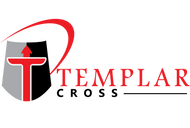



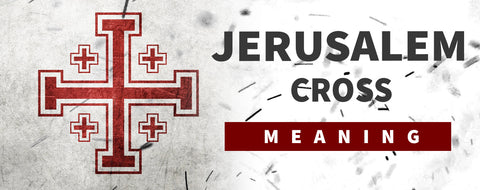
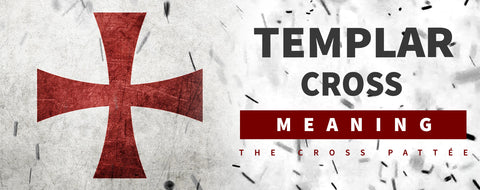
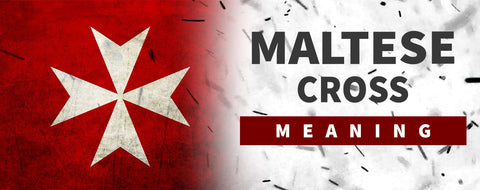
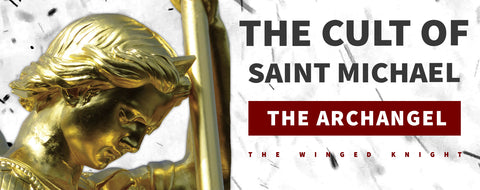
Mari
The cross its out my home its some burning the road out my door my home the same letters Hebrew Jehovah my head leters fron cross jow i know ur laguge i can giving all document my stms its crossed right left my spondylitis bones eboa bronze age my skeleton nones its righting yesuah Aramaic i asking families tourist visits the church my mother Christian orthothox become pregnant to the old home archeological trow down its a hand cross al my body’s skin hands foot right down Ethiopia cross angels church fish letters yesuah bird hagia eirini olive eugenis 😪 my mama i cant show u my painting pictures I right ur Languages how can i know i speaking Aramaic prayer i know everything i sow them mama father dhed giving me tow times milk portoguese languge front the peoole 6..pm morning all was lookik i cry i go tush her hand dont allowed i dring the milk shes was singings and cry she was lookin there the stone i know what is down the cross the Torah’s papyrus 👁️💔😪🙏mama dont go.my mother Christian orthothox listening me my big sister the house nearly it was 3 to archeological olive i become in live 1968 15/ june ano Domini era cronus plz how we can chat life i take out my blouse to the tourist visitors there pls i say them what is in my bones that say yesuah my father clonus root of olive they understand the see the craves of eboa i askin and that leters fir ancients empires leters they say yes yesua Maryam of esrael 👁️😪💔🙏shes open.my hand close my right hand to the big market u know and i know i am always with u shes dark coffee colour the girls to the market the shocked where she’s gone she lost mari what’s happened the stone my hands kyrie eleison fetus clonus stone face root of olive contact me plz my veins blood your languages torahs 😪🙏ielei 😪🙏iavu 😪🙏anokhi ohano ielei eleisin Elijah 😪🙏🫴giving me ur hand love ypomoni hope 🙏🪽🪽🪽🐟🦠🪱🙅🩷🩵🤍🦶x y right Anatolia Helios light white🧠mama my heart 😪 ❤️🔥mama its my heart malachi amos 12